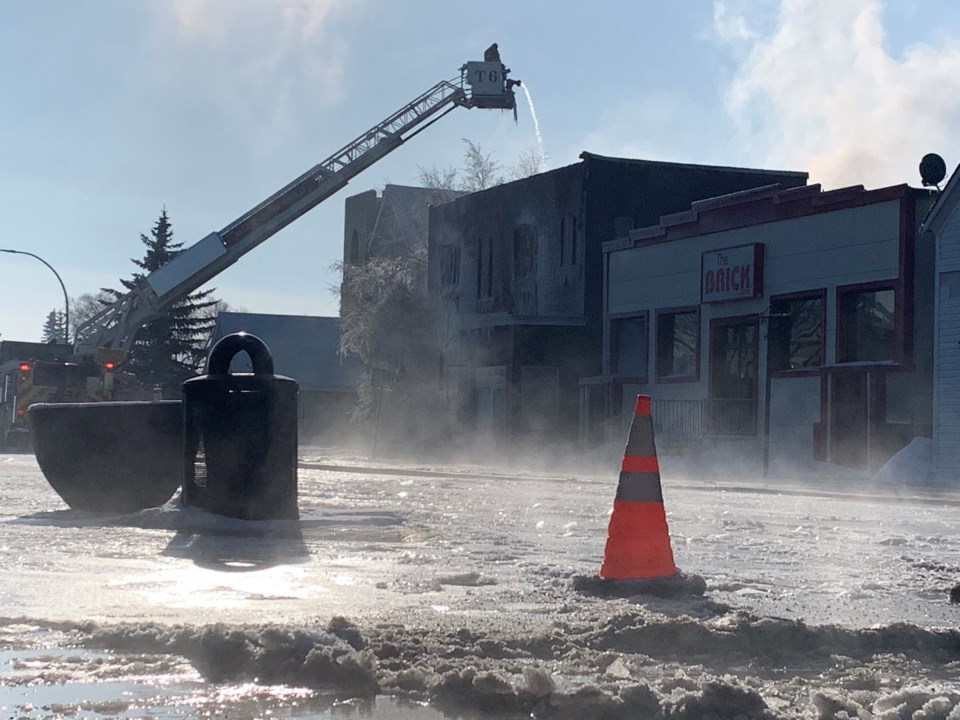WESTLOCK – The Town of Westlock is banking on an $80,000 water distribution leak detection system to curtail the $270,000-plus it spent this year on water that never made it to residents’ taps.
In 2021, the town lost 20 per cent of all the potable water it paid for from the regional water commission — $276,270 that, in essence, flowed into the ground. In a Dec. 20 interview, CAO Simone Wiley said the 20 per cent figure is an overall number, which counts everything from line leaks and breaks, to fighting fires and flushing hydrants — any water that isn’t metered. For example, the loss percentage spiked at 27.9 in January 2021 due to a handful of water main breaks and the massive Commerce Building fire, but sat at only 15 per cent in July.
And while they don’t have a definitive percentage attributed to leaky pipes, Wiley estimates the annual overall loss somewhere in the 12-15 per cent range.
“After we’ve been monitoring the water loss and using the listening devices for a year then we’ll have a much better idea of what the actual loss is,” she said.
Council and admin say this has been an ongoing issue that has been next to unsolvable as Wiley, who’s worked at the town since 2014 and has spent the last two years as CAO, notes that “until a leak surfaces … even then water finds the path of least resistance, so it can surface a significant ways away from where the actual leak is.” Simply tearing up roads to search for leaks that haven’t surfaced is neither affordable, or realistic, she said.
“It’s very frustrating. We’ve just had a hard time putting together a project and figuring what it looks like and then swallowing the initial, upfront cost. Because when you spread the cost of the water out, you see it, but it’s not quite as prevalent as when you have a project and it’s going to cost $80,000. But we know that it makes sense,” said Wiley.
“When you look at how much water loss there is it makes good financial sense to do the project to mitigate the leaks. And aside from the financial business case there is certainly an environmental stance to be taken as well … you’re treating water to let it seep into the ground.”
In a Dec. 15 interview, mayor Ralph Leriger said the leak-detection system is something council “is really excited about” as they’ve been looking at different tech over the past eight years to try and solve the problem but haven’t been able to “find an affordable solution that we were confident in that would provide a good result.”
“This goes back to my first year on council, really trying to quantify the amount of leakage … certainly some of that number is attributed to flushing of hydrants and fire practice and all those kinds of things. But what is the leakage that you don’t know about and what damage does it cause?” he asked. “We’ve been looking at different technology over the last two terms and it looks like (operations director) Robin (Benoit) has put together a really interesting program for us.”
The new $80,000 system, which was highlighted during capital budget discussions at council’s Dec. 13 meeting, combines technology from Bell Canada and Mueller Water Products and will be able to all-but-pinpoint current and pending water leaks and alert crews.
“It will be very close to where the actual leak is happening so that we’re not digging a huge area to try and find where the leak is. It will allow us to make informed decisions and put them in priority,” Wiley explained. “When you can find a leak in a pipe before it surfaces you can schedule it and you’re not paying overtime costs (for work) and aren’t causing damage to the base of a road. There are a lot of operational efficiencies attached to this program as well.”
At the Dec. 13 meeting Benoit said 65 “pucks” will be mounted on fire hydrants around the community and feed data back to the town. Benoit said the monitoring system and subsequent leak fixes should also take stress off the lagoon system as some of the lost water invariably makes it way there.
“And because we’re capturing everything in our GIS system then after we go in (and fix a section) we note what’s been done,” said Wiley.
And while the system should help curtail loss, fundamentally the problem is with the age of the pipes — an issue all Alberta municipalities face. Wiley said they’ve been tracking the loss annually and have seen the average “slowly increase over time.”
“It’s not been a huge increase, but it has been increasing. And the older the infrastructure gets the potential is greater for more water loss,” she said.
“This is an issue for municipalities big and small. We’ve heard many communities talk about infrastructure deficit and this (project) is, in my opinion, a way to extend the life of the infrastructure as you can find that pinhole before it becomes a big hole.”



